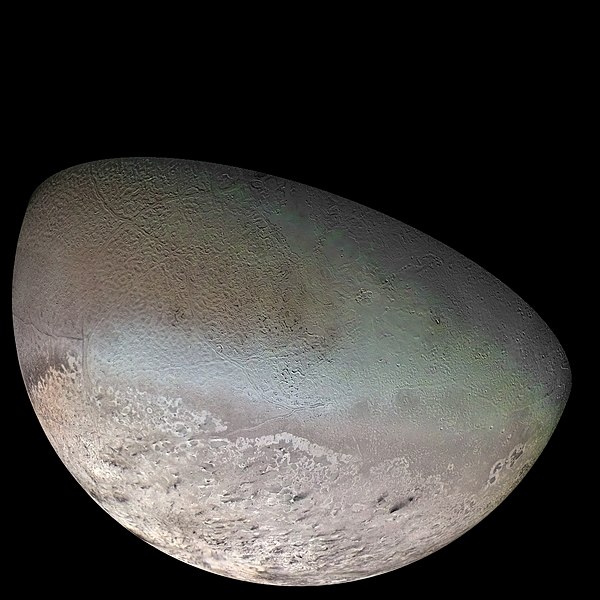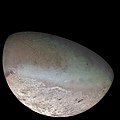پەڕگە:Triton moon mosaic Voyager 2 (large).jpg

قەبارەی ئەم پێشبینینە: ٦٠٠ لە ٦٠٠ پیکسەڵ. ڕێزەلووشنەکانی تر: ٢٤٠ لە ٢٤٠ پیکسەڵ | ٤٨٠ لە ٤٨٠ پیکسەڵ | ٧٦٨ لە ٧٦٨ پیکسەڵ | ١٬٠٢٤ لە ١٬٠٢٤ پیکسەڵ | ٢٬٠٤٨ لە ٢٬٠٤٨ پیکسەڵ | ٤٬٧٠٠ لە ٤٬٧٠٠ پیکسەڵ.
پەڕگەی سەرەکی (٤٬٧٠٠ × ٤٬٧٠٠ پیکسڵ، قەبارەی پەڕگە: ١٢٫١١ مێگابایت، جۆری ئێم ئای ئێم ئی: image/jpeg)
مێژووی پەڕگە
کرتە بکە لەسەر یەکێک لە ڕێکەوت/کاتەکان بۆ بینینی پەڕگەکە بەو شێوەی لەو کاتەدا بووە.
| ڕێکەوت/کات | ھێما | ئەندازە | بەکارھێنەر | تێبینی | |
|---|---|---|---|---|---|
| هەنووکە | ١٩:٤٠، ١٠ی تشرینی یەکەمی ٢٠١١ |  | ٤٬٧٠٠ لە ٤٬٧٠٠ (١٢٫١١ مێگابایت) | Jbarta | Minimally compressed JPG from TIFF original at NASA. This image has already been colored by NASA. I think we have no business trying to "fix" the coloring. The only alteration made from the NASA original is to enlarge the canvas to enclose the complete sp |
| ٢١:٠٠، ١ی کانوونی دووەمی ٢٠١٠ |  | ٤٬٦٠٠ لە ٤٬٦٠٠ (٢٫٨١ مێگابایت) | Supportstorm | Image Adjustments: Auto levels on contrast and color | |
| ٢١:٥٩، ١٨ی شوباتی ٢٠٠٨ |  | ٤٬٦٠٠ لە ٤٬٦٠٠ (١٫٧١ مێگابایت) | Kaldari | same image, better dimensions | |
| ٠٤:٥٩، ٨ی نیسانی ٢٠٠٥ |  | ٤٬٥٠٠ لە ٣٬٥٠٠ (١٫٩٦ مێگابایت) | Bricktop | same image, higher resolution | |
| ١٧:١٣، ٣ی نیسانی ٢٠٠٥ |  | ١٬٠٢٤ لە ٧٩٦ (١٥٠ کیلۆبایت) | Smartech~commonswiki | A color mosaic of Triton, Neptune's moon (large). Taken by Voyager 2 in 1989. Color was synthesized by combining high-resolution images taken through orange, violet, and ultraviolet filters; these images were displayed as red, green, and blue images and |
بەکارھێنانی پەڕگە
ئەم پەڕەیە ئەم پەڕگەیە بەکار دەھێنێت:
بەکارھێنانی سەرانسەریی پەڕگە
ئەم ویکیانەی دیکەی خوارەوەش ئەم پەڕگە بەکاردێنن:
- بەکارھێنان لە af.wikipedia.org
- بەکارھێنان لە an.wikipedia.org
- بەکارھێنان لە ar.wikipedia.org
- بەکارھێنان لە ary.wikipedia.org
- بەکارھێنان لە arz.wikipedia.org
- بەکارھێنان لە ast.wikipedia.org
- بەکارھێنان لە azb.wikipedia.org
- بەکارھێنان لە az.wikipedia.org
- بەکارھێنان لە ba.wikipedia.org
- بەکارھێنان لە be-tarask.wikipedia.org
- بەکارھێنان لە be.wikipedia.org
- بەکارھێنان لە bg.wikipedia.org
- بەکارھێنان لە bn.wikipedia.org
- بەکارھێنان لە bn.wikibooks.org
- بەکارھێنان لە bs.wikipedia.org
- بەکارھێنان لە ca.wikipedia.org
بینینی بەکارھێنانی گشتی زیاتری ئەم پەڕگەیە.


